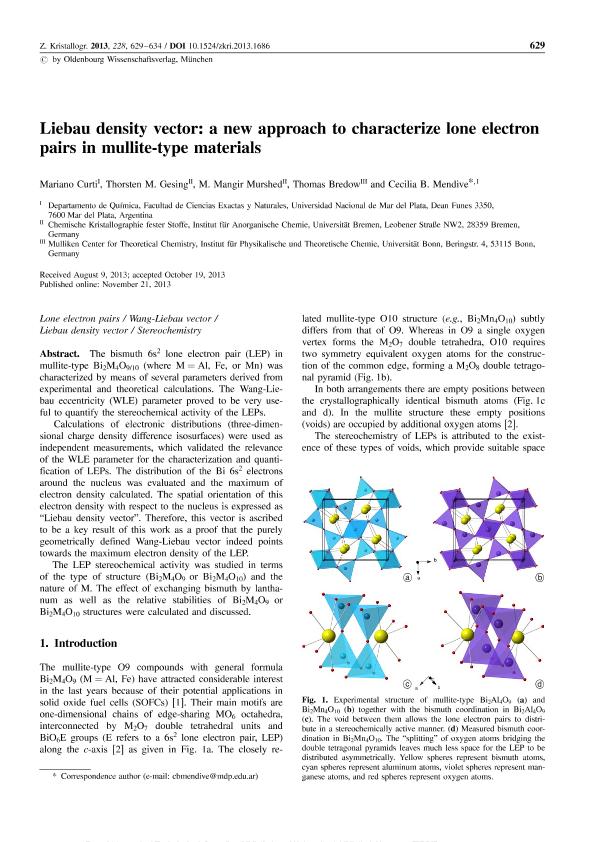Mostrar el registro sencillo del ítem
dc.contributor.author
Curti, Mariano

dc.contributor.author
Gesing, Thorsten M.
dc.contributor.author
Mangir Murshed, M.
dc.contributor.author
Bredow, Thomas Horst Julius

dc.contributor.author
Mendive, Cecilia Beatriz

dc.date.available
2017-10-03T17:07:36Z
dc.date.issued
2013-12
dc.identifier.citation
Curti, Mariano; Gesing, Thorsten M.; Mangir Murshed, M.; Bredow, Thomas Horst Julius; Mendive, Cecilia Beatriz; Liebau density vector: a new approach to characterize lone electron pairs in mullite-type materials; Oldenbourg Verlag; Zeitschrift Fur Kristallographie; 228; 12; 12-2013; 629-634
dc.identifier.issn
0044-2968
dc.identifier.uri
http://hdl.handle.net/11336/25758
dc.description.abstract
The bismuth 6s2 lone electron pair (LEP) in mullite-type Bi2M4O9/10 (where M = Al, Fe, or Mn) was characterized by means of several parameters derived from experimental and theoretical calculations. The Wang-Liebau eccentricity (WLE) parameter proved to be very useful to quantify the stereochemical activity of the LEPs. Calculations of electronic distributions (three-dimensional charge density difference isosurfaces) were used as independent measurements, which validated the relevance of the WLE parameter for the characterization and quantification of LEPs. The distribution of the Bi 6s2 electrons around the nucleus was evaluated and the maximum of electron density calculated. The spatial orientation of this electron density with respect to the nucleus is expressed as “Liebau density vector”. Therefore, this vector is ascribed to be a key result of this work as a proof that the purely geometrically defined Wang-Liebau vector indeed points towards the maximum electron density of the LEP. The LEP stereochemical activity was studied in terms of the type of structure (Bi2M4O9 or Bi2M4O10) and the nature of M. The effect of exchanging bismuth by lanthanum as well as the relative stabilities of Bi2M4O9 or Bi2M4O10 structures were calculated and discussed.
dc.format
application/pdf
dc.language.iso
eng
dc.publisher
Oldenbourg Verlag

dc.rights
info:eu-repo/semantics/openAccess
dc.rights.uri
https://creativecommons.org/licenses/by-nc-sa/2.5/ar/
dc.subject
Lone Electron Pairs
dc.subject
Wang-Liebau Vector
dc.subject
Liebau Density Vector
dc.subject
Stereochemistry
dc.subject.classification
Otras Ciencias Químicas

dc.subject.classification
Ciencias Químicas

dc.subject.classification
CIENCIAS NATURALES Y EXACTAS

dc.subject.classification
Otras Ciencias Físicas

dc.subject.classification
Ciencias Físicas

dc.subject.classification
CIENCIAS NATURALES Y EXACTAS

dc.title
Liebau density vector: a new approach to characterize lone electron pairs in mullite-type materials
dc.type
info:eu-repo/semantics/article
dc.type
info:ar-repo/semantics/artículo
dc.type
info:eu-repo/semantics/publishedVersion
dc.date.updated
2017-09-29T14:41:32Z
dc.journal.volume
228
dc.journal.number
12
dc.journal.pagination
629-634
dc.journal.pais
Alemania

dc.journal.ciudad
Munich
dc.description.fil
Fil: Curti, Mariano. Universidad Nacional de Mar del Plata. Facultad de Ciencias Exactas y Naturales. Departamento de Química; Argentina
dc.description.fil
Fil: Gesing, Thorsten M.. Universitat Bremen; Alemania
dc.description.fil
Fil: Mangir Murshed, M.. Universitat Bremen; Alemania
dc.description.fil
Fil: Bredow, Thomas Horst Julius. Universitaet Bonn; Alemania
dc.description.fil
Fil: Mendive, Cecilia Beatriz. Universidad Nacional de Mar del Plata. Facultad de Ciencias Exactas y Naturales. Departamento de Química; Argentina. Consejo Nacional de Investigaciones Científicas y Técnicas; Argentina
dc.journal.title
Zeitschrift Fur Kristallographie

dc.relation.alternativeid
info:eu-repo/semantics/altIdentifier/doi/http://dx.doi.org/10.1524/zkri.2013.1686
dc.relation.alternativeid
info:eu-repo/semantics/altIdentifier/url/https://www.degruyter.com/view/j/zkri.2013.228.issue-12/zkri.2013.1686/zkri.2013.1686.xml
Archivos asociados
